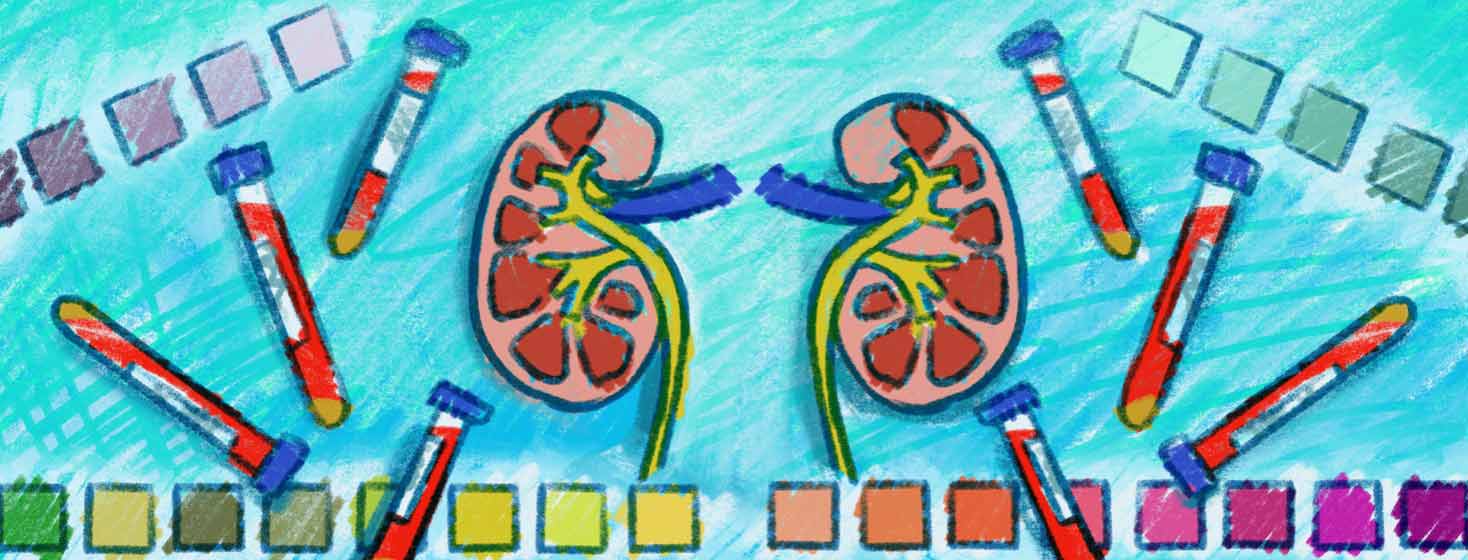How Are Rare Kidney Diseases Diagnosed?
Reviewed by: HU Medical Review Board | Last reviewed: February 2023 | Last updated: July 2023
Many rare kidney diseases cause long-term damage. This damage can cause the kidneys to work less and less well over time. So, early diagnosis is key. The sooner you know you have kidney disease, the sooner you can treat it.1
Most people have 2 kidneys, and they have a very crucial function. Throughout the day, they filter and remove excess water and waste from your blood, turning it into pee (urine). If your kidneys are not working well, water and waste build up in your body.1,2
There are several tests that doctors use to diagnose and monitor kidney disease. These include blood tests, urine tests, imaging tests, and more.1
Blood tests
The main blood test used for checking kidney function measures your glomerular filtration rate (GFR). The GFR test tells how well your kidneys are filtering your blood. It also helps your doctor determine how advanced your rare kidney disease is. This is known as its stage.1,3,4
Your GFR number takes into account your age, sex, and body size, as well as the levels of creatinine in your blood. Creatinine is a waste product produced by normal wear and tear of the muscles. It is usually filtered out by the kidneys. When your creatinine levels are high, your kidneys may not be effectively filtering it.3,4
Another helpful blood test is a comprehensive metabolic panel (CMP). A CMP measures 14 different substances in the blood. These measurements, or levels, provide information about how well different organs and systems in your body are working.5
Urine tests
Your pee can also tell your doctor a lot about your kidney function. There are 2 urine tests used to check kidney function. Both check for albumin in your urine. Albumin is a protein that shows up in your pee when your kidneys are not working well. Having albumin in your pee could be a sign of kidney disease.6
Your doctor may use one or both of the following urine tests to check your urine albumin levels:6
- Dipstick test: In this test, a strip of paper that has been chemically treated is placed into your urine sample. If the paper changes color, albumin is present.
- Urine albumin-to-creatinine ratio (UACR): This urine test measures the ratio of albumin to creatinine in your pee.
Imaging tests
Imaging tests take pictures of the inside of your body using advanced technology. An expert in interpreting imaging scans called a radiologist interprets these tests.7-9
Imaging tests can be helpful in spotting problems related to the kidneys, such as:7-10
- Fluid buildup
- Inflammation
- Tumors or lesions
- Any disruption to the urinary system
- Kidney stones
Your doctor may order one or more of the following imaging tests to get a detailed look at your kidneys:7-10
- Ultrasound – Ultrasounds use sound waves to look at your kidneys and the surrounding area.
- Kidney, ureter, and bladder (KUB) X-ray – KUB X-rays take pictures of your urinary tract, bladder, and kidneys. The ureters carry urine from your kidneys to your bladder.
- Computed tomography (CT) scan – CT scans offer more precise imaging of the kidneys than KUB X-rays. They use a combination of X-rays and computer technology.
- Intravenous pyelogram (IVP) or intravenous urogram (IVU) – This special kind of X-ray looks at the whole urinary system, including the kidneys, ureters, and bladder. During an IVP, a contrast dye is injected into a vein. The dye shows up on X-ray images, allowing a radiologist to see it as it moves through your urinary system. Dye that does not move or moves too slowly may mean there is a blockage or problem with kidney function.
Kidney biopsy
In some cases, your doctor may recommend a kidney biopsy. This is when a small tissue sample is taken from your kidney to analyze in a lab. A biopsy is done only when other tests have not provided clear answers and the cause of your kidney disease cannot be explained.11
Before the biopsy, your doctor gives you local anesthesia to numb the area. Then, they insert a long, thin needle through your skin and into one of your kidneys. With this needle, they remove a small tissue sample to send to a lab, where experts can study it.11
Kidney biopsies are especially important in diagnosing rare kidney diseases that affect the glomeruli. The glomeruli are a network of tiny blood vessels that help filter the blood in the kidneys. Diseases like IgA nephropathy (IgAN) and Complement 3 glomerulopathy (C3G) often can be diagnosed this way.12-14
By looking at the tissue sample under a microscope or staining it with special dyes, your doctor can look for changes to the normal glomeruli or kidney structure.11-14
Genetic testing
Many forms of rare kidney disease are genetic. These include Fabry disease, Alport syndrome, and polycystic kidney disease (PKD). Some are linked to known genetic changes (mutations).15
A genetic counselor or doctor who specializes in genetics can recommend genetic tests to look for these mutations. They can also interpret the results to help make a final diagnosis.16
Things to consider
Some of these tests require some preparation beforehand, such as not eating or drinking (fasting) for several hours. Talk with your care team about what you need to do to prepare for these tests and any concerns you may have.4
Together with a medical history and physical exam, these tests can help determine how well your kidneys are working and the cause of your rare kidney disease. They also guide your doctors in giving you the right treatment.4

Join the conversation